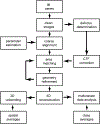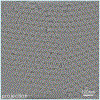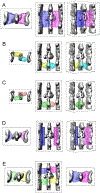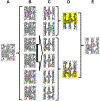Electron tomography of paracrystalline 2D arrays
- PMID: 23132074
- PMCID: PMC7032944
- DOI: 10.1007/978-1-62703-176-9_23
Electron tomography of paracrystalline 2D arrays
Abstract
Paracrystalline arrays possess specific types of disorder that reduce the structural information as well as resolution when spatially averaged over repeating motifs. Electron tomography combined with motif classification and averaging can solve the heterogeneity problem and provide information on the structural elements that give rise to the disorder. This chapter describes procedures that would be used in a typical tomography application to identify and characterize a paracrystalline specimen. Particular emphasis is given to actively contracting insect flight muscle, a specimen with particularly difficult to characterize structural heterogeneity and 2D paracrystalline arrays of myosin-V, from which a particularly high resolution motif average was obtained. All aspects of the study are described including data collection, merging of micrographs to produce the tomogram, alignment to an invariant structural element, classification and averaging of heterogeneous structures, and reassembly of focused class averages into high signal-to-noise ratio representations of the original raw repeats. Particular emphasis is placed on limitations of the various processes to produce the final class averages.
Figures









Similar articles
-
Tomographic subvolume alignment and subvolume classification applied to myosin V and SIV envelope spikes.J Struct Biol. 2009 Feb;165(2):64-77. doi: 10.1016/j.jsb.2008.10.004. Epub 2008 Nov 8. J Struct Biol. 2009. PMID: 19032983 Free PMC article.
-
Cryo-Electron Tomography and Subtomogram Averaging.Methods Enzymol. 2016;579:329-67. doi: 10.1016/bs.mie.2016.04.014. Epub 2016 Jun 22. Methods Enzymol. 2016. PMID: 27572733 Review.
-
Subtomogram averaging from cryo-electron tomograms.Methods Cell Biol. 2019;152:217-259. doi: 10.1016/bs.mcb.2019.04.003. Epub 2019 May 15. Methods Cell Biol. 2019. PMID: 31326022 Review.
-
Methods for identifying and averaging variable molecular conformations in tomograms of actively contracting insect flight muscle.J Struct Biol. 2009 Dec;168(3):485-502. doi: 10.1016/j.jsb.2009.08.007. Epub 2009 Aug 19. J Struct Biol. 2009. PMID: 19698791 Free PMC article.
-
Using Tomoauto: A Protocol for High-throughput Automated Cryo-electron Tomography.J Vis Exp. 2016 Jan 30;(107):e53608. doi: 10.3791/53608. J Vis Exp. 2016. PMID: 26863591 Free PMC article.
Cited by
-
Insights into Actin-Myosin Interactions within Muscle from 3D Electron Microscopy.Int J Mol Sci. 2019 Apr 5;20(7):1703. doi: 10.3390/ijms20071703. Int J Mol Sci. 2019. PMID: 30959804 Free PMC article. Review.
-
Myosin S2 origins track evolution of strong binding on actin by azimuthal rolling of motor domain.Biophys J. 2015 Mar 24;108(6):1495-1502. doi: 10.1016/j.bpj.2014.12.059. Biophys J. 2015. PMID: 25809262 Free PMC article.
References
-
- Liu J, Taylor DW, Krementsova EB, Trybus KM, and Taylor KA (2006) Three-dimensional structure of the myosin V inhibited state by cryoelectron tomography. Nature 442, 208–211. - PubMed
-
- Taylor KA, Tang J, Cheng Y, and Winkler H (1997) The use of electron tomography for structural analysis of disordered protein arrays. J. Struct. Biol 120, 372–386. - PubMed
-
- Zhu P, Liu J, Bess J Jr., Chertova E, Lifson JD, Grise H, et al. (2006) Distribution and three-dimensional structure of AIDS virus envelope spikes. Nature 441, 847–852. - PubMed
Publication types
MeSH terms
Substances
Grants and funding
LinkOut - more resources
Full Text Sources

